The Austrian APC
Unlike many other European Countries, the bulk of the Austrian tracked APC force during the Cold War was not based on US-supplied M113. Instead, the Austrians used a locally-produced model designed in 1956. At that time, Osterreichische Saurer-Werke from Vienna started development of an Armored Personnel Carrier. This first prototype was presented two years later as the 3K 3H. The following year, the improved 4K 3H was developed. Both were propelled by a Saurer 3H 200 hp diesel engine. The next 4K 2P prototype had a revised torsion bar suspension and a 250 hp 2P engine. The final prototype was the 4K 4F in 1961. This is the vehicle which entered production. The 4K 3FA and 4K 4FA series only differed by their engine. No less than 445 vehicles in various versions were delivered by OSW, and production lasted until 1969. The company was integrated into Steyr-Daimler-Puch AG in 1970. At that stage, the 4K 4FA was replaced by the 4K 7FA, which shared components with the Kürassier SK-105.Design of the Saurer 4K 4FA
The vehicle was relatively similar to the contemporary West German Schützenpanzer 12-3. The hull was prismatic, made of RHA welded steel and presented a low profile. It could withstand 20 mm (0.79 in) projectiles on the frontal arc, while the sloped sides andrear could protect against small arms fire. The driver sat in the front part of the vehicle, on the left, with the engine on the right. The driver's hatch had a two-piece cover, with three periscopes in front of it. The central one could be swapped for a night vision device.On the basic APC version, the 4K 4FA-G1, a gunner/commander's cupola was mounted in the fore-center with a shielded 0.50 inch (12.7 mm) M2 Browning machine gun. The rear compartment housed 8 fully-equipped equipped infantrymen, seated facing the interior on side benches.
The section leader could use an observation hatch with a day periscope placed on the right-hand side of the vehicle. The soldiers could exit the vehicle through the rear doors, but outside-opening hatches were also placed in the roof, which allowed the infantrymen to fire on the move while standing. The APC also had four mounting sockets for MG 42 machine guns along the sides, front and rear.
The vehicle had no NBC protection or amphibious capabilities. Depending on the version, the 6-cylinder Saurer water-cooled turbocharged diesel engine provided either 200 or 250 hp (184 kW) for a top speed of about 65 km/h (40 mph) on flat terrain. The suspension is of the torsion bar type.
Versions
4K 4FA-G1 (Schützenpanzer/Überschweres MG): The basic APC version with a shielded .50 cal (12.7 mm) machine-gun as its main armament. A sub-version exists, armed with an Oerlikon Contraves 81 mm (3.19 in) rocket launcher, but was built only in small numbers.4K 4FA-G2 (Grenadier-Schützenpanzer): The IFV version (grenadier APC) armed with a belt-fed 20 mm (0.79 in) Oerlikon Contraves Model 204 GK autocannon housed in a one-person turret (+70° -12° elevation/depression) replacing the commander's cupola. 100 rounds in storage.
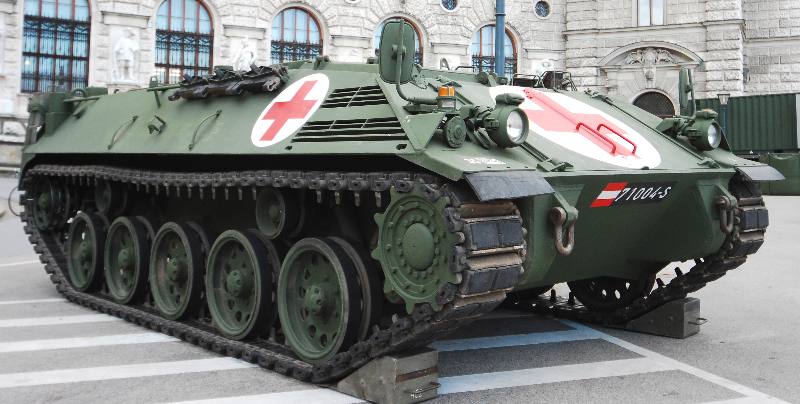
4K 4FA SAN armored ambulance
4FA-SAN (Sanitäter): Unarmed, armored ambulance version. Interior modified for 2 stretchers, seating for 4 injured passengers, and space for medical equipment and personnel.
4K 4F GrW1 (Granatwerfer-SPz): The 81 mm (3.18 in) Mortar Carrier version, which had a range between 600 and 5400 meters (660-5900 yds). Could fire 6-25 rounds per minute on average. The rear section was modified to house the projectiles and mortar. A single prototype GrW2 tried a 120 mm (4.72 in) mortar.
4K 3FA Fu1/FuA/Fu/F1A: Command versions, respectively Brigade, Artillery and AA command post vehicles. 4K 3FA FS: Wireless Teleprinter vehicle.
4K 4F SPz A1/LWT: This Schützenpanzer was modified to operate the MBDA Mistral man-held SAM systems. Section vehicle of Pz1FAL batteries.
4K 7FA: An advanced 1970 version, mass-produced with a 320 hp diesel.
ELVO Leonidas: The Greek version, based on the evolved 4K 7FA and built by Elvo from 1981 to 1987. It was given a M2 Browning Machine Gun and more powerful 320 hp engine (102 built). The Leonidas 2 followed in 1987 (592 built).
Service
The 4FA entered service in 1961 and rapidly equipped Austrian mechanized infantry divisions, grenadier and specialized units. These were gradually decommissioned in the 1990s and are now retired. Bolivia purchased the 4K4FA-SB20 Greif Armored Recovery Vehicles and Nigeria's Boko Haram militias are alleged to have captured one vehicle according to defenceweb.co.za.Links
The Saurer 4K 4FA on WikpediaThe Saurer 4K 4FA on Army-Guide
Saurer 4FA specifications |
|
| Dimensions | 5.4 x 2.5 x 2.1 m 17'8''x8'2''x6'11'' |
| Total weight, battle ready | G1: 12.5 tons (25,000 lbs) G2: 15 tons (30,000 lbs) |
| Crew | 2+8 (driver, gunner, 8 infantrymen) |
| Propulsion | 6-cyl Saurer diesel, 250 hp (184 kw) |
| Suspension | Torsion bars |
| Speed (road) | 65 km/h (40 mph) |
| Range | 370 km (230 mi) |
| Armament | G1: cal.50 (12.7 mm) Browning machine-gun G2: 20 mm (0.79 in) Oerlikon Contraves M204 GK |
| Armor | Est. 8 mm sides to 20 mm front (0.31-0.79 in) |
| Total production | 445 in 1961-1969 |
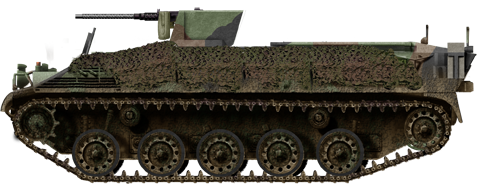
4K 4FA-G1 basic APC version

4K 4FA-G2 Infantry Fighting Vehicle/Grenadier version, armed with the one-man turret Oerlikon 20 mm (0.79 in) autocannon.
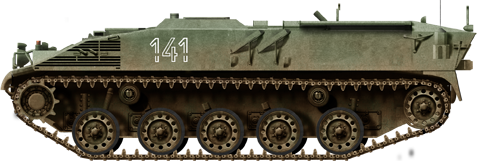
4F GrW1 81 mm (3.19 in) mortar-carrier version.
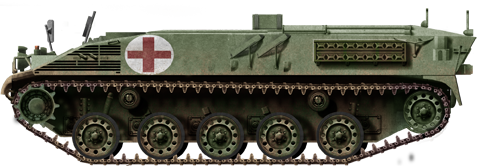
4K 4FA-SAN, armored ambulance version.
Video: The 4FA in action
Gallery
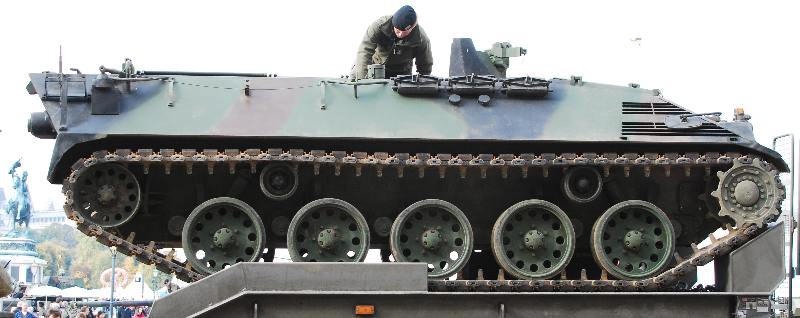
4K 4FA G1 APC on a trailer, 2008.
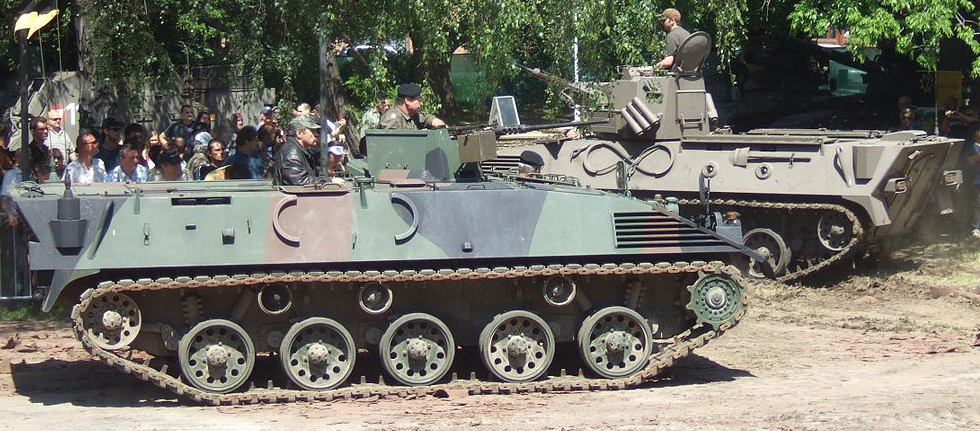
SPz at Rädern und Ketten 2010
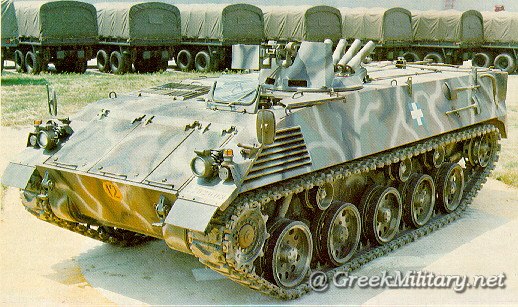 ELVO Leonidas
ELVO Leonidas

Cold War Tanks


































Cold war tanks posters

Cold War Main Battle Tanks

Cold War Soviet Army
Museums, Movies, Books & Games
The Tanks and Armor in pop culture
Tanks and armored vehicles in general are only really grasped when seen first person: The mass, the scale, it's all there. Explore also the way tanks were covered in the movie industry, in books and in video games.Movies:
Best tanks movie on warhistoryonline.com
On imdb.com
On bestsimilar.com/
miltours.com
liveabout.com/
watchmojo.com
Video Games:
pcgamesn.com
historyhit.com
levvvel.com
vg247.com/best-tank-games
mmobomb.com/
alienwarearena.com

